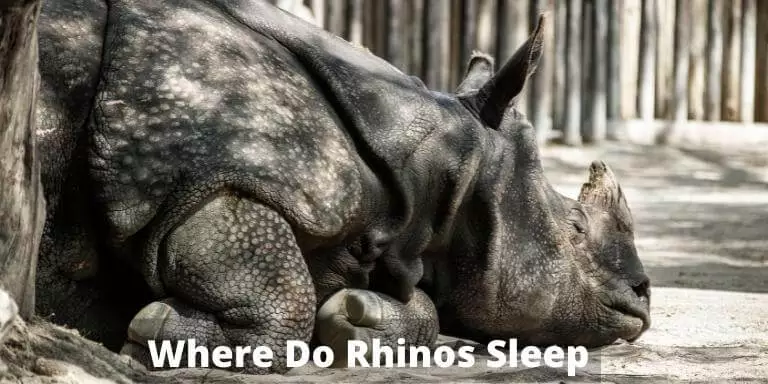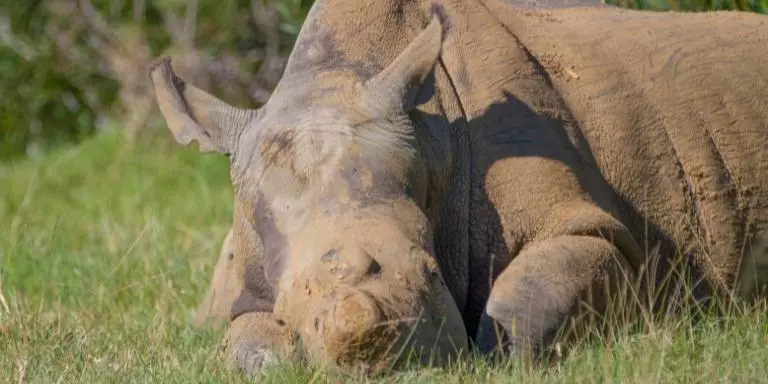Rhinoceros is one of the largest creatures and needs to hustle a lot. As a result, they need plenty of sleep and rest. But where do rhinos sleep?
Their nap cycles are greatly dictated by the weather, the environment, the presence of other animals, etc. However, they still find a way to rest for up to 9 to 10 hours every day. The Rhino’s napping routine may vary from species to species. Some of them are nocturnal and others are diurnal.

How Much Sleep Does a Rhinoceros Require?
The snoozing cycles of the rhinoceros depend on the weather, the temperature, the food they eat, the environment they are in, and so on. But in general, Rhinoceros requires sleep for about 8 to 10 hours a day. Though due to harsh conditions, it often gets about 3 to 4 hours of rest a day.
Where Do Rhinos Sleep?

The remaining species of the rhino have chosen Africa and Asia as their habitat. Two of the species (The African black rhino and the African white rhino) are found to be in Africa and the rest in Asia (The greater one-horned Rhino, The Sumatran, and The Javan).
Black Rhinoceros

Where they sleep: These beasts love to eat woody and fibrous vegetation. So they choose their habitats where such food grows in handsome density. The densely protected forests help the animal maintain its privacy and security.
When they rest: During the last century, the population of the black rhino has been drastically damaged by human hands. Incidents such as heavy hunting, poaching, and killing of these animals for capitalistic uses have greatly changed their behavior and napping routines. They have become mostly nocturnal now.
Types of rest: The black rhinoceroses dislike the heat of the sun. As a result, they are often seen resting or dozing under the shade of bushes and small trees. They also snooze in the mud wallows while taking a healthy mud bath.
How they sleep: Black Rhinos can sleep while both standing or lying down. But their legs are folded under them when they lie down. Many of them just take a nap lying flat on one side.
White Rhinoceros

Where they sleep: These species choose their habitats as savannahs and dry plains as they are heavy grazers. They are one of the biggest mammals walking in Africa. Though their numbers are now extremely minimized due to excessive poaching. As a result, they are mostly conserved in national parks and safari parks. They also like shaded areas for resting.
When they rest: They are active during some hours of both the night and the day. They eat during dawn and dusk when the temperature is bearable and tend to rest during midday.
How they sleep: They prefer lying down to standing when it comes to napping. But they do not sleep on their sides. Moreover, their siesta is highly affected by the temperature.
Indian Rhinoceros
Where they sleep: The animal generally prefers grasslands near rivers. They are more likely to hide behind a thicket than to be out in the open. Their numbers were terribly endangered once but now their population is seeing an upward slope after taking proper steps.
When they rest: The horned giant grazes most of the time of day and night and naps during the time when the temperature is the most bearable.
Types of rest: The Indian giant often sleeps, dozes, takes a small nap, or even takes a long dip in the mud. When the sun is the hottest during the day the rhino often submerges itself in the muddy wallow. It stays there for as long as the temperature is not the most bearable. After that, it gets out and starts looking for food.
Javan Rhinoceros
Where they drowse: Javan rhino prefers dense jungle. They are Asian and are generally found in dense rainforests. Though once they preferred the floodplains, now their population is only found in higher grounds and protected parks. This occurrence is due to excessive hunting of their kind.
When they rest: This herbivore is both diurnal and nocturnal. Which means they alternate eating and resting during both day and night.
How they sleep: The single-horned Javan snoozes on its feet or lying down as per its will.
Sumatran Rhinoceros
Where they drowse: These are the smallest species and the only ones with hair on the body. The versatile creature is Asian and is found around swamps, rainforests, and moss forests.
When they rest: Their snoozing schedule is the same as their other Asian cousins. They are both nocturnal and diurnal.
Types of rest: The Sumatrans are the only ones with dark and dense hair. As a result, to keep their body cool they are often seen to take mud baths. This mud sticks on the hair and keeps their body temperature cool and protects them from insects.
They submerge in the mud wallows or lie on their side with mud on their whole body and nap like a baby. The sun rays can do zero damage to the skin under the thick mud layer.
How they sleep: They can easily take a nap while lying down behind their thickets. They doze under big trees while standing.
A Sleeping Baby Rhino

Babies always stick with their mothers. Even when they are about to sleep they require both physical and mental company. But due to harsh poachers, many babies are losing their mothers. This results in great mental trauma for the infant.
Conclusion
The African black rhinos are the only nocturnal ones among the five species. The others are both nocturnal and diurnal. Again, baby rhinos are afraid of napping alone. They need someone by their side during the night out there in the wild.
You might also be interested in:
- Why Do Rhinos Charge? A Tourist Survival Guide
- Do Rhinos Have Predators? Top 5 Predators that can kill Rhinos
- How to Stop Rhino Poaching | Anti-Poaching Guide
- How Long Do Rhinos Live? Rhino Life Cycle Explained
- How Much Does a Rhino Weigh? Animalia Facts
- How Fast Can a Rhino Run? All 5 Species Speed Comparison
- Can Rhinos Jump or Walk Backwards?
- Do Rhinos Lay Eggs? Rhino Reproduction Explained

